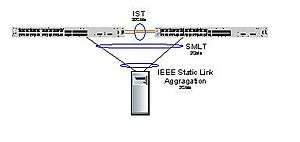Split multi-link trunking
| Split Multi-Link Trunking | |
| SMLT mesh with nine 1Gig paths (all connections active and load balancing traffic) 9Gbit/s full duplex mesh providing 18Gbit/s of bandwidth between core switches. | |
Split Multi-Link Trunking (SMLT) is a Layer-2 link aggregation technology in computer networking originally developed by Nortel as an enhancement to standard multi-link trunking (MLT) as defined in IEEE 802.3ad. US 7173934, Lapuh, Roger; Yili Zhao & Wassim Tawbi et al., "System, Device, and Method for Improving Communication Network Reliability Using Trunk Splitting", issued 2007-02-06
Link aggregation or MLT allows multiple physical network links between two network switches and another device (which could be another switch or a network device such as a server) to be treated as a single logical link and load balance the traffic across all available links. For each packet that needs to be transmitted, one of the physical links is selected based on a load-balancing algorithm (usually involving a hash function operating on the source and destination Media Access Control (MAC) address information). For real-world network traffic this generally results in an effective bandwidth for the logical link equal to the sum of the bandwidth of the individual physical links. Redundant links that were once unused due to Spanning Tree’s loop protection can now be used to their full potential.
A general limitation of standard link aggregation, MLT or EtherChannel is that all the physical ports in the link aggregation group must reside on the same switch. The SMLT, DSMLT and RSMLT protocols remove this limitation by allowing the physical ports to be split between two switches, allowing for the creation of Active load sharing high availability network designs that meet five nines availability requirements.
SMLT Topologies
The two switches between which the SMLT is split are known as aggregation switches and form a logical cluster which appears to the other end of the SMLT link as a single switch.
The split may be at one or at both ends of the MLT. If both ends of the link are split, the resulting topology is referred to as an "SMLT square" when there is no cross-connect between diagonally opposite aggregation switches, or an "SMLT mesh" when each aggregation switch has a SMLT connection with both aggregation switches in the other pair. If only one end is split, the topology is referred to as an SMLT triangle.
In an SMLT triangle, the end of the link which is not split does not need to support SMLT. This allows non-Avaya devices including third-party switches and servers to benefit from SMLT. The only requirement is that IEEE 802.3ad static mode must be supported.
Operation

The key to the operation of SMLT is the Inter-Switch Trunk (IST). The IST is a (standard) MLT connection between the aggregation switches which allows the exchange of information regarding traffic forwarding and the status of individual SMLT links.
For each SMLT connection, the aggregation switches have a standard MLT or individual port with which an SMLT identifier is associated. For a given SMLT connection, the same SMLT ID must be configured on each of the peer aggregation switches.
For example, when one switch receives a response to an ARP request from an end-station on a port that is part of an SMLT, it will inform its peer switch across the IST and request the peer to update its own ARP table with a record pointing to its own connection with the corresponding SMLT ID.
In general, normal network traffic does not traverse the IST unless this is the only path to reach a host which is connected only to the peer switch. By ensuring all devices have SMLT connections to the aggregation switches, traffic never needs to traverse the IST and the total forwarding capacity of the switches in the cluster is also aggregated.
The communication between peer switches across the IST allows both unicast and multicast routing information to be exchanged allowing protocols such as Open Shortest Path First (OSPF) and Protocol Independent Multicast-Sparse Mode (PIM-SM) to operate correctly.
Failure Scenarios
 The use of SMLT not only allows traffic to be load-balanced across all the links in an aggregation group but also allows traffic to be redistributed very quickly in the event of link or switch failure. In general the failure of any one component results in a traffic disruption lasting less than half a second (normal less than 100 millisecond[1][2]) making SMLT appropriate in environments running time- and loss-sensitive applications such as voice and video.
The use of SMLT not only allows traffic to be load-balanced across all the links in an aggregation group but also allows traffic to be redistributed very quickly in the event of link or switch failure. In general the failure of any one component results in a traffic disruption lasting less than half a second (normal less than 100 millisecond[1][2]) making SMLT appropriate in environments running time- and loss-sensitive applications such as voice and video.
In a network utilising SMLT, it is often no longer necessary to run a spanning tree protocol of any kind since there are no logical bridging loops introduced by the presence of the IST. This eliminates the need for spanning tree reconvergence or root-bridge failovers in failure scenarios which causes interruptions in network traffic longer than time-sensitive applications are able to cater for.
SMLT Types
- MLT-based Split Multi-Link Trunking (SMLT)
- Distributed Split Multi-Link Trunking (DSMLT)
- Single port Split Multi-Link Trunking (SSMLT)
Product Support
SMLT is supported within the following Avaya Ethernet Routing Switch (ERS) and Virtual Services Platform (VSP) Product Families: ERS 1600, ERS 5500, ERS 5600, ERS 7000, ERS 8300, ERS 8800, ERS 8600, MERS 8600, VSP 9000
SMLT is fully interoperable with devices supporting standard MLT (IEEE 802.3ad static mode).
See also
- Avaya
- Nortel
- Link aggregation
- Multi-link trunking
- R-SMLT
- Distributed Split Multi-Link Trunking
- EtherChannel
- High availability
- List of Nortel patents
- Nortel Simple Loop Prevention Protocol
- Virtual Enterprise Network Architecture
References
- ↑ "Evaluation of Resilient Routing Switches for Real-Time Multimedia Traffic with Microsoft Live Communications Server 2005 and Nortel MCS 5100" (PDF). The Tolly Group.
- ↑ "National University of Malaysia Unleashes Student Learning With Nortel; New High Performance Network To Enhance New Educational Approaches". M2 Presswire. June 17, 2009. Retrieved 2 Sep 2011.
The network will utilize Nortel's SMLT (Split Multi-Link Trunking) technology, which provides exceptional resiliency to ensure voice, video and other applications stay connected despite link, switch or site equipment failures.
Further reading
- "Capacity of Nortel data network increased by University of Ballarat.". Telecom World Wire. April 28, 2008.
- "Eliminate single points of failure" (PDF). Retrieved 3 Sep 2011.
External links
| Look up SMLT in Wiktionary, the free dictionary. |
| Wikimedia Commons has media related to Nortel. |
| Wikimedia Commons has media related to Avaya. |
| |||||||||||||||||||||||||||||||||||||||||||
